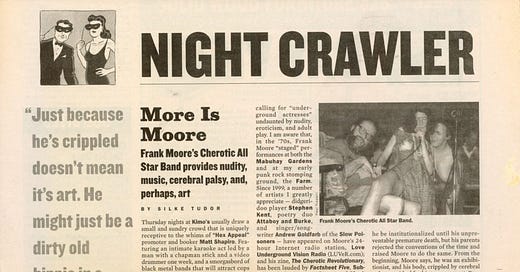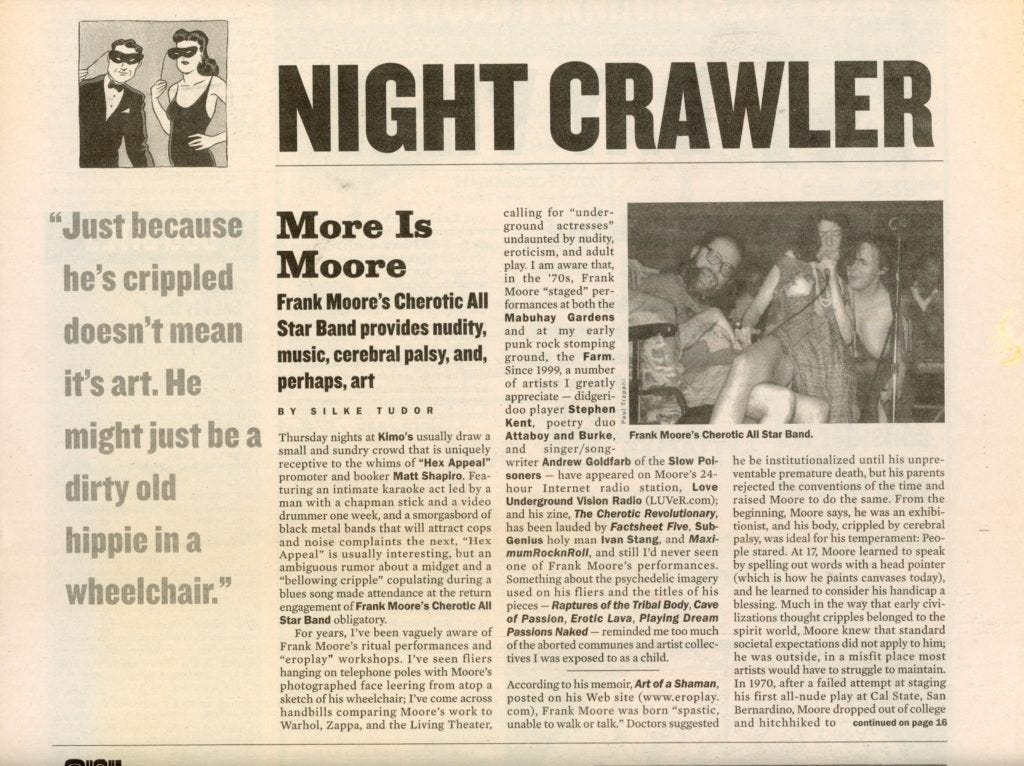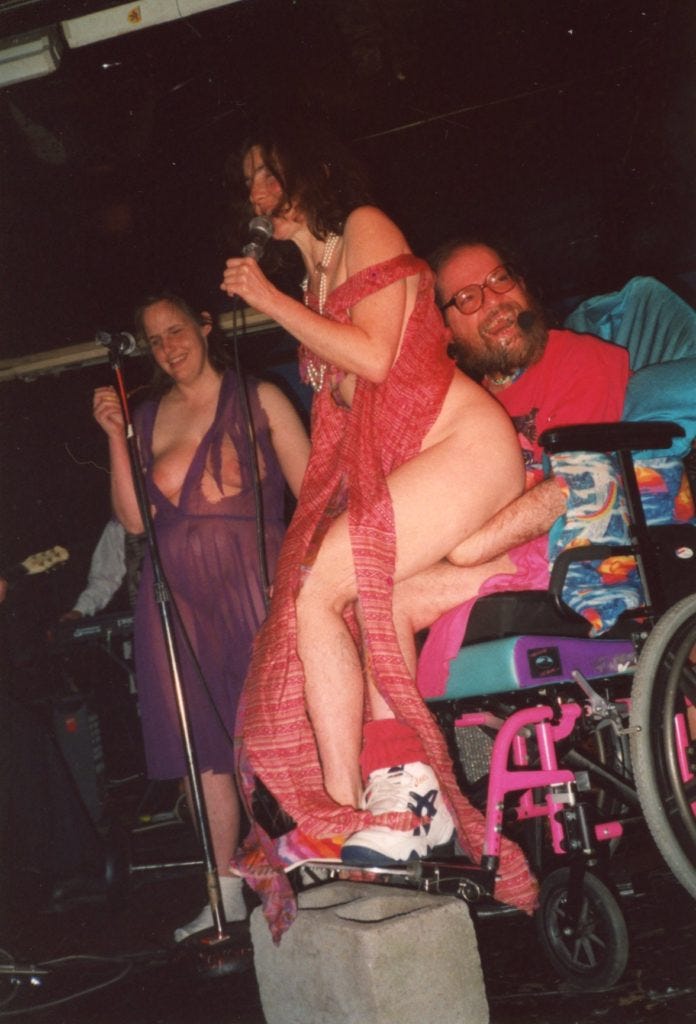More is Moore
A review written by Silke Tudor, for SF Weekly, of a performance by Frank Moore’s Cherotic All-Star Band at Kimo’s in San Francisco, April 5, 2001.
More is Moore
Frank Moore’s Cherotic All Star Band provides nudity, music, cerebral palsy, and, perhaps, art
By Silke Tudor
published: May 02, 2001
Thursday nights at Kimo’s usually draw a small and sundry crowd that is uniquely receptive to the whims of “Hex Appeal” promoter and booker Matt Shapiro. Featuring an intimate karaoke act led by a man with a chapman stick and a video drummer one week, and a smorgasbord of black metal bands that will attract cops and noise complaints the next, “Hex Appeal” is usually interesting, but an ambiguous rumor about a midget and a “bellowing cripple” copulating during a blues song made attendance at the return engagement of Frank Moore’s Cherotic All Star Band obligatory.
For years, I’ve been vaguely aware of Frank Moore’s ritual performances and “eroplay” workshops. I've seen fliers hanging on telephone poles with Moore’s photographed face leering from atop a sketch of his wheelchair; I’ve come across handbills comparing Moore’s work to Warhol, Zappa, and the Living Theater, calling for “underground actresses” undaunted by nudity, eroticism, and adult play. I am aware that, in the ’70s, Frank Moore “staged” performances at both the Mabuhay Gardens and at my early punk rock stomping ground, the Farm. Since 1999, a number of artists I greatly appreciate -- didgeridoo player Stephen Kent, poetry duo Attaboy and Burke, and singer/songwriter Andrew Goldfarb of the Slow Poisoners -- have appeared on Moore’s 24-hour Internet radio station, Love Underground Vision Radio (LUVeR.com); and his zine, The Cherotic Revolutionary,has been lauded by Factsheet Five, SubGenius holyman Ivan Stang, and MaximumRocknRoll, and still I’d never seen one of Frank Moore’s performances. Something about the psychedelic imagery used on his fliers and the titles of his pieces -- Raptures of the Tribal Body, Cave of Passion, Erotic Lava, Playing Dream Passions Naked -- reminded me too much of the aborted communes and artist collectives I was exposed to as a child.
According to his memoir, Art of a Shaman, posted on his Web site (www.eroplay. com), Frank Moore was “spastic, unable to walk or talk.” Doctors suggested he be institutionalized until his unpreventable premature death, but his parents rejected the conventions of the time and raised Moore to do the same. From the beginning, Moore says, he was an exhibitionist, and his body, crippled by cerebral palsy, was ideal for his temperament: People stared. At 17, Moore learned to speak by spelling out words with a head pointer (which is how he paints canvases today), and he learned to consider his handicap a blessing. Much in the way that early civilizations thought cripples belonged to the spirit world, Moore knew that standard societal expectations did not apply to him; he was outside, in a misfit place most artists would have to struggle to maintain. In 1970, after a failed attempt at staging his first all-nude play at Cal State, San Bernardino, Moore dropped out of college and hitchhiked to Santa Fe, where a rich woman asked that he paint a portrait of her in the nude. The realization that “art gave people permission to do what was normally considered forbidden” led him to start workshops and nude rituals he called “nonfilms,” which explored the boundaries of human intimacy through nudity. The communal family that sprang up around Moore eventually relocated to Berkeley in 1975, where Moore met his life partner Linda Mac and started workshops that turned Berkeley into a strange playground of Moore’s devising: Participants buried each other alive in coffins and staged rebirths; they drank urine and launched fantasy costume parades; they staged a multimedia carnival called “The Erotic Test”; they staged theater pieces for which actors trained by working at strip clubs; they took part in political protests and benefits; they started a cabaret show, titled The Outrageous Beauty Revue, in which Frank Moore sang in spite of, and because of, his difficulty in forming words; they held public rituals during which people could “play” with each other without actually having sex. This became the essence of eroplay. In the early '90s, Jesse Helms investigated Moore for being obscene, but that only encouraged Moore. Over the years, he has held countless rituals in the Bay Area, with each running as little as 40 minutes and as long as 48 hours.
“The difference between eroplay and foreplay is one of intent,” writes Moore. “Physically, there is no difference. It is the same pleasurable, physical turned-on feeling. But ... eroplay is satisfying in itself, in relaxing intensity. There is no build-up of pent-up energy in one climactic act.”
For the tenderfoot, Frank Moore's Cherotic All Star Band, an ever-changing musical entity, is a moderate introduction.
“I’ve played with Frank numerous times,” says Andrew Goldfarb, who met Moore through LUVeR radio, “both solo and with my band. Last time we performed was inside a produce warehouse in Richmond. We sang “This Land Is Your Land” together. Frank played piano and, even though he has cerebral palsy, it sounded like he was channeling Thelonious Monk. Frank Moore is a true American, a real example of someone who knows how to turn lemons into lemonade.”
Goldfarb recalls breaking his foot eight hours before a performance with Frank Moore.
“I was going to cancel,” says Goldfarb, “but I thought, “I’m opening for Frank Moore, I can’t cancel.” Frank has invented a new language for [public performance]. Don’t always understand what he’s up to, but he causes me to examine my notions of sexism, sex, monogamy, and the animal/psychological duality of modern living. He’s an amazing inspiration for anyone seeking freedom of expression without any physical or mental boundaries.”
Frank Moore arrives at Kimo’s with his entourage -- a young five-piece band, Linda Mac, and a blind backup singer/ flutist named Teresa Cochran -- wearing little more than a shirt, orange socks, and mismatched shoes. As Moore points to letters on his spelling board with lurching movements of his head, Mac interprets: “Frank says he likes people.” Moore grins through his feral beard, exposing large, misshapen teeth. His tongue lolls suggestively. Moore recommends that John the Baker take off his pants, and the small crowd applauds encouragingly.
“I’ve already seen you naked anyway,” spells Moore.
“This I gotta see,” says Cochran with a grin, her pendulous breasts swaying under a sheer garment. John the Baker disrobes and the set begins with Linda Mac singing over distorted cello and keyboard loops. Moore begins to howl, rising in his wheelchair, his back bowed with effort as his arms flap irregularly at his side. Mac smiles, swirling in her see-through robe, rubbing up against guitarist Giovanni Moro, which sends Moore into a spasm of excited grunts and wails. He grins and mugs for the cameras as the music builds. Mac lifts her skirt and rubs her ass against Moore’s lap. He rears in his seat, pushing against her with paroxysmal thrusts, matching her off-balance singing with supportive growls. Cochran lights a pipe and begins smoking as Moore’s hand lurches between Mac’s legs. The musicians play on, rolling over the stage with bluesy guitar riffs and spontaneous percussion. Cochran edges her way toward Moore’s wheelchair, feeling for Mac’s ass as Moore’s hand fumbles for Cochran’s breast. They grunt and wail as Mac continues singing and grinding on Moore’s lap. The crowd watches -- some dumbfounded, some delighted -- as cameras flash and Moore bellows. While Mac seems to keep the song in place, the energy of the scene escalates and ebbs along with Moore’s directing vocal rumble. His stamina is unrelenting, and the music goes on and on. I am repelled but stuck: I can't turn away, until, finally, Matt Shapiro indicates with a flick of the lights that the set has reached its conclusion.
Satisfied, Moore grins lecherously, and Mac announces that their CD is called Dying Is Sexy.
“That’s the most punk rock thing I’ve seen in years,” says a young man who has moved to the front of the stage with a camera. “Where do you go from there?”
“Just because he’s crippled doesn’t mean it’s art,” counters another. “He might just be a dirty old hippie in a wheelchair.”
“I don't know who’s more crazy,” says a woman standing outside the nightclub, “the people performing or the people watching.”
Frank Moore says the crazy person performs insane rituals not to express himself, but to keep the sky from falling. And the sky doesn’t fall.
Original article is here: https://archives.sfweekly.com/sanfrancisco/more-is-moore/Content?oid=2141589
Email between Silke and Frank after the article was published:
From: "silke tudor" <silke@sirius.com>
To: "Frank Moore" <fmoore@eroplay.com>
Sent: Thursday, May 03, 2001 7:23 AM
Subject: Re: just read your article
thank you for your help, it was not the easiest article I've written.
Frank Moore wrote:
> it definately is one of the best, deepest articles written about my
> work. you captured a lot! thank you.
>
> In Freedom
> Frank Moore
> Visit http://www.eroplay.com
> Listen to LUVeR!
> http ://www. luver.com
> LUVeR Alternative News
> http://www.luver.org
Watch the performance:






